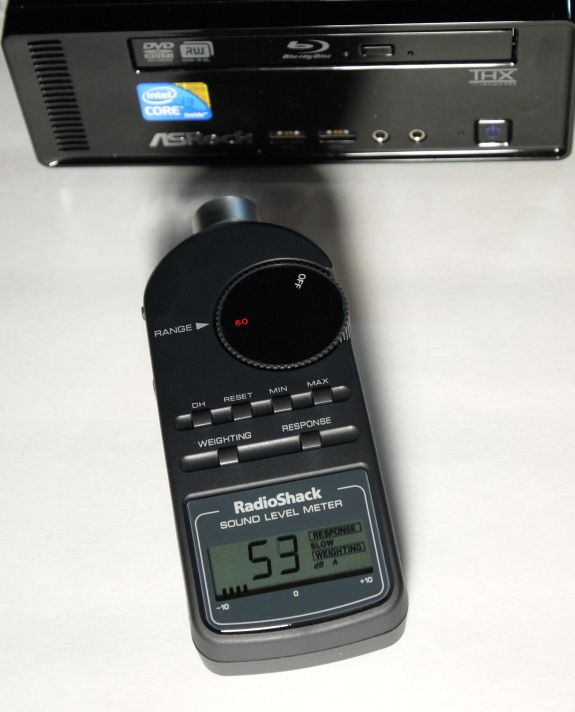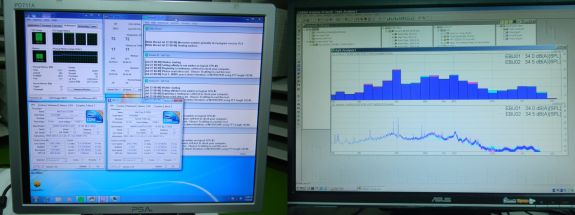ASRock Core 100HT-BD : Bringing HTPCs to the Mainstream Market [UPDATED : Noise Issue]
by Ganesh T S on July 19, 2010 9:34 PM EST- Posted in
- Home Theater
- Arrandale
- ASRock
- Media Streamer
- Core i3
- HTPC
HTPC enthusiasts are rightly concerned about the noise factor, heat and power consumption, ease of usage and many other criteria. We will tackle each of these concerns one by one in this section.
Noise
ASRock claims that the Core 100 HT-BD produces less than 25dB of noise. Under lab testing conditions, such performance is indeed possible. We decided to get hold of one of the sound meters used in setting up home theater speakers to verify whether the claims were true. Being a hobbyist sound meter, it wasn't very sensitive. The measurable sound range was only 50 - 130 dB, and there was a concern that the Core 100 would be too silent for the sound meter to pick up. As it turned out, while running Prime95 at full throttle (100% CPU utilization), the fans kicked in at full speed. The sound meter registered between 53 and 55 dB very close to the unit. [ See UPDATE below for a more practical measurement ]
The fan noise is quite audible if one sits very close to the unit. From 8 ft away, even with the unit in the open, we could barely hear it. Noise, however, is a very subjective issue. We hope the quoted number will help give readers an idea of how noisy the system gets when fully loaded. If the unit is going to be installed inside a cabinet of some sort, the noise factor becomes a non-issue.
UPDATE: One of the reasons we kept our sound detector very close to the unit was because it refused to register any measurement at the usual practical distances. While waiting to get hold of a more sensitive sound meter, we asked ASRock for lab results of sound measurement at full throttle. They were happy to oblige us with the following photographs and video from their anechoic chamber. It appears that the sound level is less than 35dB at a distance of 2 ft. even with all fans in action.
Power Consumption
In order to get an idea of the power consumption numbers, the Prime95 benchmark was let run overnight to keep the system completely loaded for an extended duration. All the four 'cores' of the CPU were pegged at 100% throughout, and we found an average power consumption of less than 48 W. At idle, the system consumed around 18 W.
These type of power consumption numbers have been enabled by ASRock's choice of going in for an Arrandale instead of a Clarkdale platform. This has resulted in a smaller form factor case design for the mini-ITX motherboard. Since there is not much heat to be dissipated, the cooling system is also appropriately small and silent.
Ease of Use
HTPC enthusiasts are concerned about how easy it is for their system to come out of standby. Existence of HDMI handshake issues upon return from standby is also a deal breaker for many. Fortunately, the Core 100 HT-BD has no issues in these two aspects. As long as the AC power adapter is connected to the system, the bundled MCE remote can be used to boot the system (even if the PC had been shut down previously). In order to shorten the boot times, ASRock supplies an Instant Boot utility. Using this, whenver the Core 100 HT-BD is shut down, it boots up once again and shuts down before the power can be safely removed. Upon power up, the boot up is instantaneous. If the user wants to put the PC in sleep mode, ASRock also supplies a Goodnight LED feature in the BIOS, which turns off the bright blue blinking LED in front. The MCE remote can also be used to bring the PC out of sleep mode.
Within Windows, the MCE remote can be made to work with a variety of applications such as XBMC, MediaPortal, MPC-HC and of course, Windows 7 Media Center. Blu Ray players such as PowerDVD and ArcSoft TMT can also be controlled with the help of the MCE remote. For the ideal I/O scenario, one probably needs to purchase a wireless keyboard / mouse combo.
It was seen in an earlier section that the Core 100 HT-BD happened to score quite well in the Anandtech Media Streamer Test Suite. The unit could playback all files using one program or the other, and people expect nothing else from a HTPC. Unfortunately, there is no single unified interface (from XBMC or MediaPortal or any other similar program) which could successfully play back all the files from within. There is definitely an ease of use issue existing here. However, this is not ASRock's fault, and will probably continue to exist on all Clarkdale / Arrandale platforms. Hopefully, projects such as XBMC's DSPlayer mature rapidly to alleviate this problem.













107 Comments
View All Comments
tmservo - Tuesday, July 20, 2010 - link
This is a good point regarding tuners. I also wish there was an internal. But I can deal without. Right now, I have 4 tuners: a SiliconDust dual tuner QAM (connects over ethernet) a 2250 and a ATI650. But I almost never watch that many programs at once, and with the cable companies limiting, they are on my elimination list. This fall SiliconDust is supposed to have their 3 tuner CableCard solution out. At the moment they have that, my need of any cards in my PC completely go away. Completely goes away. I'll have better TV input.Now, I wish there was a single PCI-E x1 slot so I could consider the Ceton, but I could deal.
jnmfox - Tuesday, July 20, 2010 - link
Surprised Silicon Dust's HDHomeRun hasn't been mentioned:http://www.silicondust.com/products/hdhomerun/atsc...
One of the best tuners around and will work on any networked PC. Plus you don't have to add bulk to your HTPC by making it bigger to fit a tuner inside. One of the best HTPC purchases I've made.
Braumin - Wednesday, July 21, 2010 - link
Everyone needs a different tuner. Including any tuner would just be a waste of money since it would not be guaranteed to work on the owner's system. USB and Network tuners are available and make this a complete DVR.CharonPDX - Wednesday, July 21, 2010 - link
I already use an HD HomeRun as my tuner, so no internal tuner isn't a deal killer at all for me. (And I may get a second HD HomeRun.)jrwalte - Wednesday, July 21, 2010 - link
Did you ever consider using a USB tuner?EnzoFX - Wednesday, July 21, 2010 - link
There are probably more USB based tuners these days than internal tuners being made. Secondly, I strongly recommend the network based HDHomeRun tuner. Lastly, this is probably targeted at people who wouldn't want to install an internal tuner.RamIt - Tuesday, July 20, 2010 - link
Give me an expansion slot and I'll buy one. until then no thx.ganeshts - Tuesday, July 20, 2010 - link
RamIt,Most of what can be achieved through an expansion slot is possible using external USB devices. The Core 100 unit is quite liberal in that respect, providing 6 USB 2.0 ports and 2 USB 3.0 ports.
Also, note that the chipset used is the HM55. Compare this with a similarly spec-ed notebook computer. It is difficult for manufacturers to provide expansion slots, and even if they do, the costs of the devices fitting those slots are much higher than their external USB counterparts.
Stokestack - Tuesday, July 20, 2010 - link
Unfortunately, the only USB 3 ports are on the front. This is a mistake. People setting up a nice home-theater system don't want ugly wires hanging out of their components full-time.Receiver makers are making the same baffling mistake with USB ports for iPods. Why on earth would I want this wire dangling off the front of the unit all the time? A port on the back allows you to plug a dock, an external drive, or tuner in and keep it out of sight.
GeorgeH - Tuesday, July 20, 2010 - link
At $700 this will be competing with the Mac Mini. It has superior hardware specs, but if I were looking for something small, quiet, and attractive to put in my living room the Mini would win easily. This box is just to close to a basic mini-ITX box that any troglodyte could throw together - ASRock really needs to leverage their ability to make completely custom parts before they have a truly compelling product.It's cool to see more high-powered boxes in this form factor, I just wish it had been executed better.